Georgia Tech Interdisciplinary Research Institutes Create Faculty Advisory Council
Oct 02, 2023 — Atlanta, GA
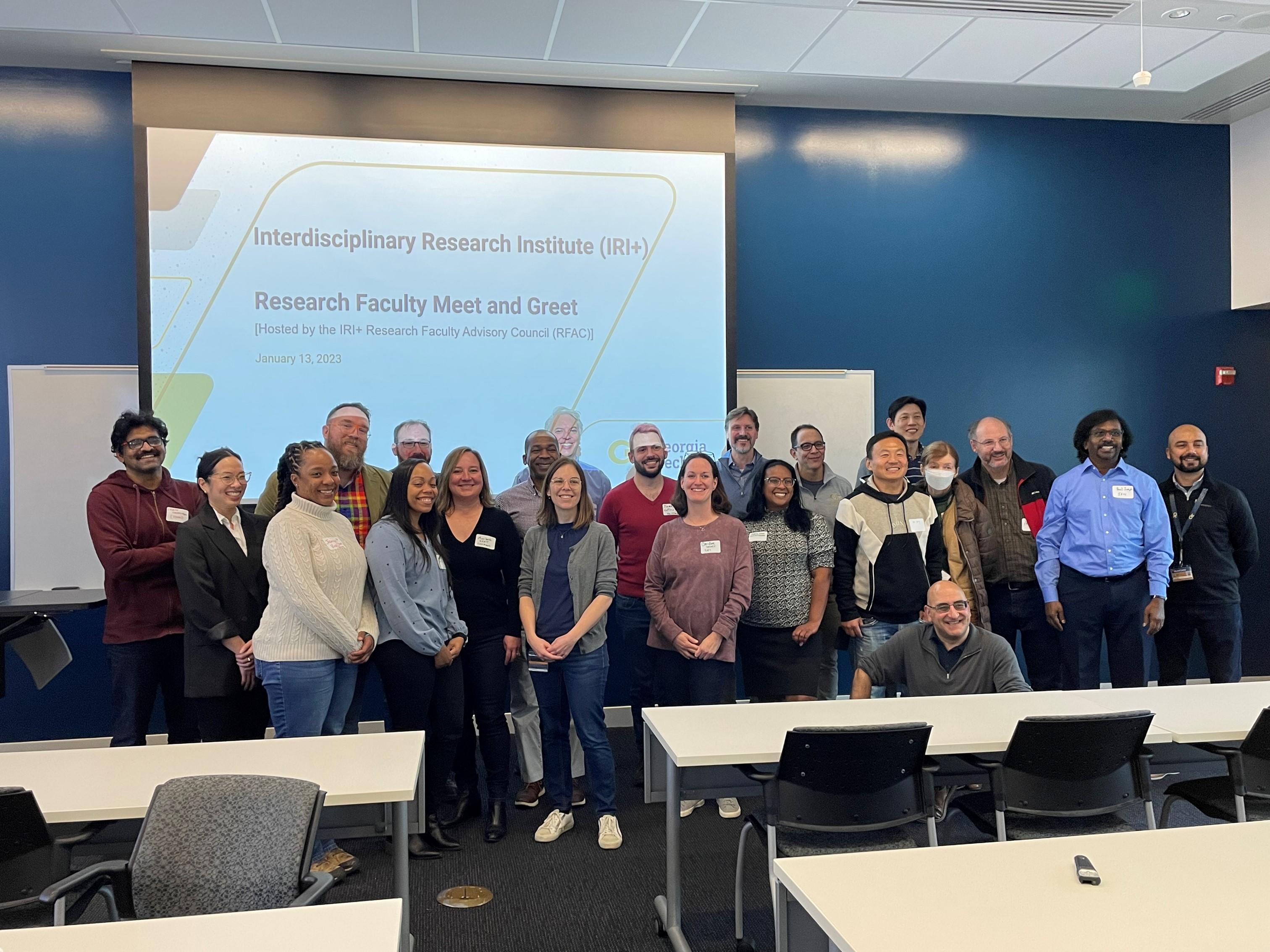
Research faculty at the Georgia Institute of Technology now have their own advocacy group. Since 2022, the Research Faculty Advisory Council (RFAC) has increased research faculty engagement and addressed concerns from researchers in the Interdisciplinary Research Institutes (IRIs), joining similar organizations that address such needs in other colleges.
The group addresses issues such as retention, professional development, recognition, and compensation. Julia Kubanek, vice president for Interdisciplinary Research (VPIR), formed the group after hearing feedback from research faculty and modeled it after a similar council in the College of Sciences.
“This advisory council has helped clarify how we can improve both the status and experience of research faculty on campus,” Kubanek said. “The recommendations they’ve provided and the initiatives they’ve launched are already making a difference.”
The 12 members are nominated from across the IRIs, plus two other interdisciplinary research units supported by the VPIR. These members include:
- Vishwadeep Ahluwalia (Center for Advanced Brain Imaging)
- Michael Chang (Brook Byers Institute for Sustainable Systems)
- Sriram Chockalingam (Institite for Data Engineering and Science)
- Christine Conwell (Strategic Energy Institute)
- Andrew Dugenske (Georgia Tech Manufacturing Institute)
- Ulrika Egertsdotter (Renewable Bioproducts Institute)
- Evan Goldberg (Global Center for Medical Innovation )
- Walter Henderson (Institute for Materials)
- Johannes Leisen (Parker H. Petit Institute for Bioengineering and Bioscience)
- Paul Joseph (Institute for Electronics and Nanotechnology)
- Leanne West (Pediatric Technology Center)
- Clint Zeagler (Institute for People and Technology)
In its first year, RFAC had two co-leads: Andrew Dugenske, the director of the Factory Information Systems Center and a principal research engineer at the Georgia Tech Manufacturing Institute, and Paul Joseph, a principal research scientist and director of External User Programs for Southeastern Nanotechnology Infrastructure Corridor.
“Although the research faculty contribute significantly to the overall growth of Georgia Tech, we remain largely underrepresented, unrecognized, and underemployed because of the lack of suitable platforms to talk about the challenges faced by research faculty colleagues,” Joseph said. “It was not a surprise that the same concerns surfaced and were discovered by the council when we collected input from the research faculty throughout the IRIs on issues that concern and are important to research faculty.”
Although Joseph and Dugenske have completed their terms in their leadership roles, they are satisfied with RFAC’s initial success in creating awareness of research faculty challenges on campus, and initiatives that include a mentorship program with the Research Next team, a Research Faculty Mentoring Network, and efforts in RFAC bylaws creation. Leanne West and Walter Henderson now serve as co-leads.
“It was great for the administration to recognize the many contributions that research faculty make to the Institute and establish a way to improve research faculty job satisfaction and engagement,” Dugenske said. “During the first year of the RFAC, the committee did a great job of gathering issues of importance to research faculty and presenting clear and actionable recommendations to decision-makers.”
Tess Malone, Senior Research Writer/Editor
tess.malone@gatech.edu
Christopher Jones Wins 2023 Institute Award for Excellence in Industrial Gases Technology
Aug 28, 2023 — Atlanta, GA
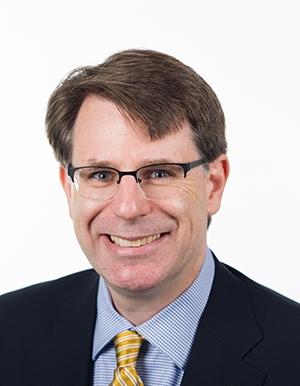
Professor Chris Jones
Professor Christopher Jones was selected as the recipient of the 2023 Institute Award for Excellence in Industrial Gases Technology from the American Institute of Chemical Engineers. (AIChE).
Jones, the John F. Brock III School Chair of Georgia Tech's School of Chemical and Biomolecular Engineering (ChBE@GT), will receive the award at the AIChE meeting in Orlando, Florida, this November.
This award recognizes his contributions to ultra-dilute CO2 separations, such as the extraction of CO2 from air, also referred to as “direct air capture” or DAC. The Jones group has played a foundational role in developing materials and processes for CO2 removal from air, and in conjunction with the Lively, Realff, Sholl, and other groups in ChBE@GT, no academic institution has authored more publications on DAC than Georgia Tech.
Professors Jones, Matthew Realff, and Ryan Lively are founding members of the Georgia Tech Direct Air Capture Center, or DirACC.
2023 RBI Seed Funding Lunch and Learn
2023 RBI Seed Funding Lunch and Learn - A great opportunity for Georgia Tech Faculty
Please join the Renewable Bioproducts Institute for lunch, meet our recently expanded industrial members, and learn about changes to the RBI fellowship funding program. Faculty will learn how to apply for seed grants, and can discuss potential project ideas, connect with potential collaborators, and gain valuable feedback from industry and RBI leadership.
2023 RBI Spring Workshop Experience From a Student's Perspective - Part 3
Sep 21, 2023 — Atlanta, GA
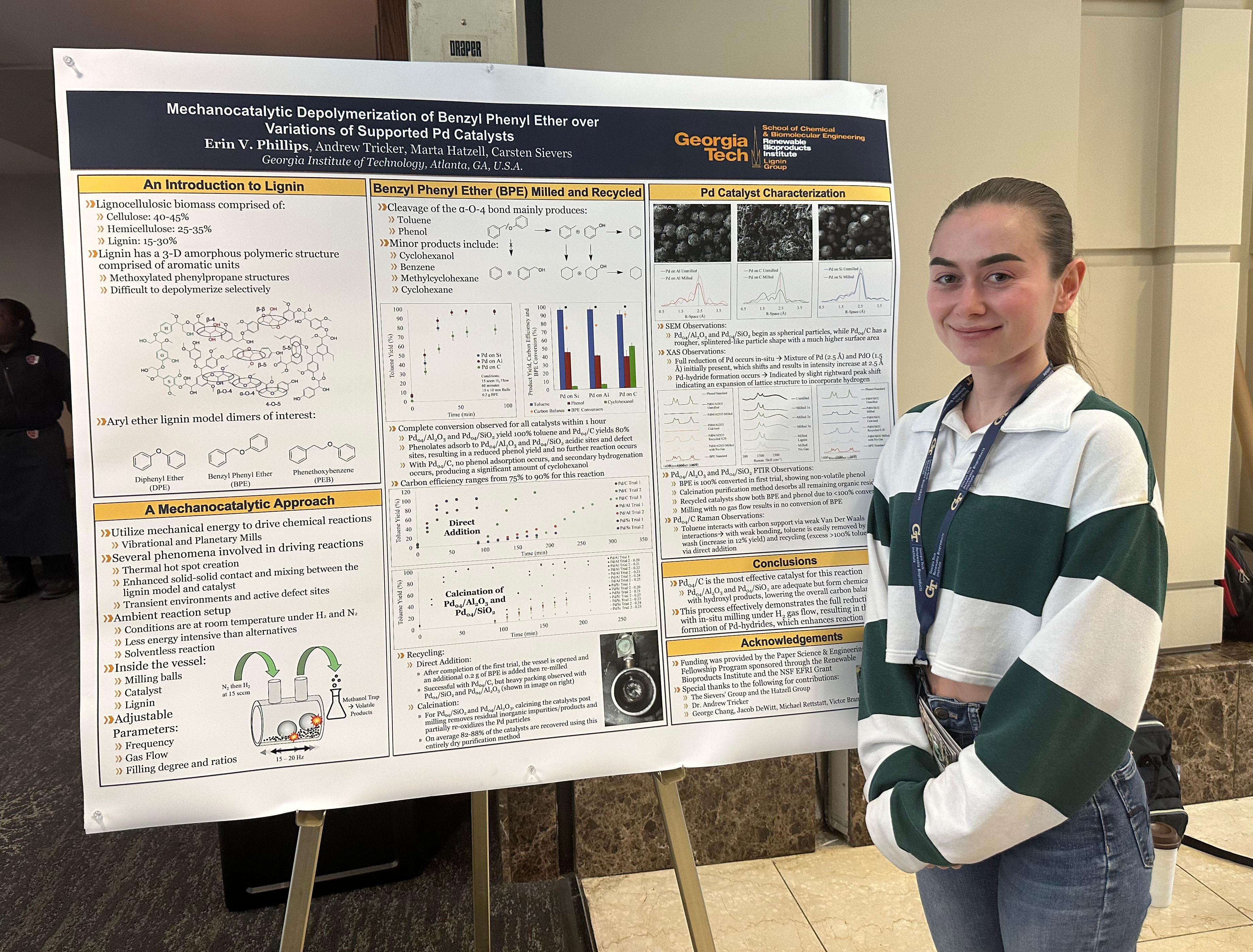
Erin Phillips at the 2033 RBI Spring Workshop
This is part three of the student experiences series. Erin Phillips, rising fourth-year Ph.D. candidate in chemistry and biochemisty shares her experience from the 2023 RBI Spring Workshop on "Innovations in Packaging and Circular Economy."
Tell us about yourself.
My name is Erin Phillips, and I am a rising fourth-year Ph.D. student here at Georgia Tech. I graduated with my bachelor's from Christopher Newport University in Newport News, Virginia, in 2020. I am a student in the School of Chemistry and Biochemistry, but I am co-advised by Carsten Sievers in the School of Chemical and Biomolecular Engineering and Marta Hatzell in the George W. Woodruff School of Mechanical Engineering. The title for my thesis project is "Mechanochemical Depolymerization of Lignin and Lignin Model Compounds." I am currently writing a JACS Communication about the cleavage of the lignin model compound benzyl phenyl ether, which represents the B-O-4 bond found within lignin.
How was your experience at the RBI workshop?
I thought the workshop was fantastic! I really enjoyed the interdisciplinary focus of the event, which allowed for greater networking opportunities between departments.
What was your main takeaway from the poster session?
During the poster session, it was great to see what other PSE (Paper Science and Engineering) fellows were currently working on. We often all take classes together and pass each other in RBI, but it was nice to actually see everyone's work laid out and visually represented. I also enjoyed talking with a few people from the industry about their expectations in terms of hiring after graduate school and what a realistic position in an industry setting would entail.
What more would you like to see in future events at the Renewable Bioproducts Institute?
I think the greatest thing RBI can do is to continue to allow for PSE fellows to build contacts that we may not normally have access to during our day-to-day lives in RBI. Many of us want to continue in our field of research after leaving Georgia Tech, so events like the RBI workshop are a great experience to connect with others who share our interest and could help provide opportunities after completing the program.
Priya Devarajan || RBI Communications Program Manager
Splitting Hairs : Identification of Unknown Materials of a Historic Papermaking Tool Through Forensics Fiber Analysis
Sep 10, 2023 — Atlanta, GA
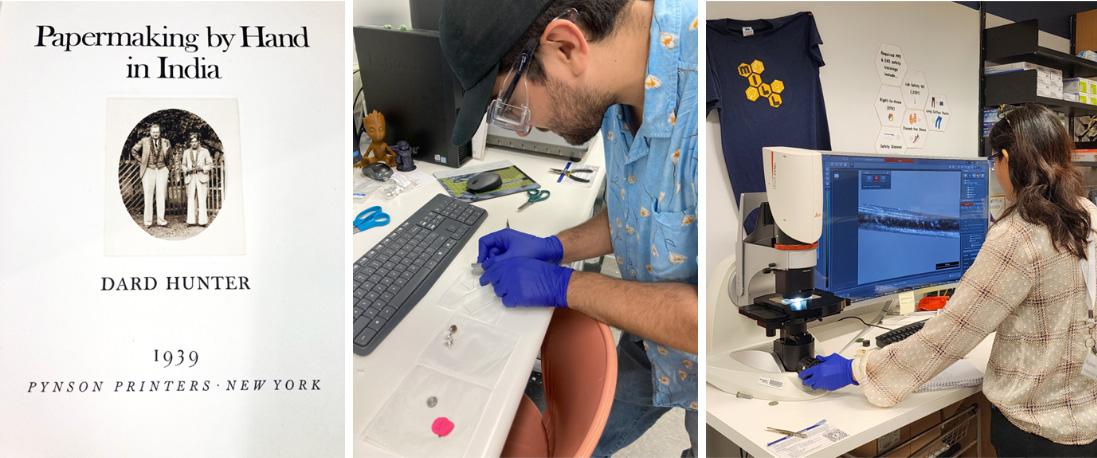
Picture of Dard Hunter and Tekumalla Venkajee during their travels in the Indian subcontinent (left). Daniel Vallejo, Ph.D., prepping the loom fiber sample for Scanning Electron Microscopy (middle), Nasreen Khan, Ph.D., analyzing loom fiber with an optical microscope (right) in Georgia Tech Microscope
Who We Are and the Paper Museum
The Robert C. Williams Museum of Papermaking houses hand papermaking artifacts from around the world. Dard Hunter, a renowned paper historian and founder of the museum, collected many of these objects throughout the early 1900s as he sought to gain more knowledge about this craft. Nearly 100 years later, the museum continues its mission to collect, preserve, increase, and disseminate knowledge about papermaking to the general public. By collaborating with Georgia Tech researchers, and the larger Atlanta community, by using scientific tools, we can unlock hidden information held within the objects, both from a historical and scientific perspective. Recently, two Georgia Tech Postdoctoral Fellows, Nasreen Khan (Paper Museum/RBI) and Daniel Vallejo (School of Chemistry and Biochemistry) sought to uncover more about a loom in the museum’s collection, connected with the history of the Indian subcontinent and Gandhi.
Dard Hunter and Background of the Loom
In the 1930s, Dard Hunter traveled to Asia and the Indian subcontinent (I.e., India, Pakistan, Bangladesh, Kashmir) to document hand papermaking techniques and collect tools and paper samples. At that time many people, including Mahatma Gandhi, aimed to revitalize the Indian hand papermaking tradition by supporting and creating schools to teach the craft [1-3]. Dard Hunter visited several papermaking villages and schools, including those helped founded by Gandhi. Hunter brought a loom back to America that was used to weave a chapri (paper-mold cover or screen), but the information of the specific origins of this loom was lost.
What’s Missing?
While Hunter and other researchers documented and studied hand papermaking tools and materials of this region and time, it was primarily from a historical and cultural perspective [1-5]. Much of their focus has been on the plant materials used to make the paper and molds [1-5]. However, some parts of the handmade molds in Asia were known to also use biological materials sourced from animals, such as silk and animal hair [1-4]. Since the exact origin of the loom and the fibers used to construct the paper mold was not known, the museum was interested in learning more about this object.
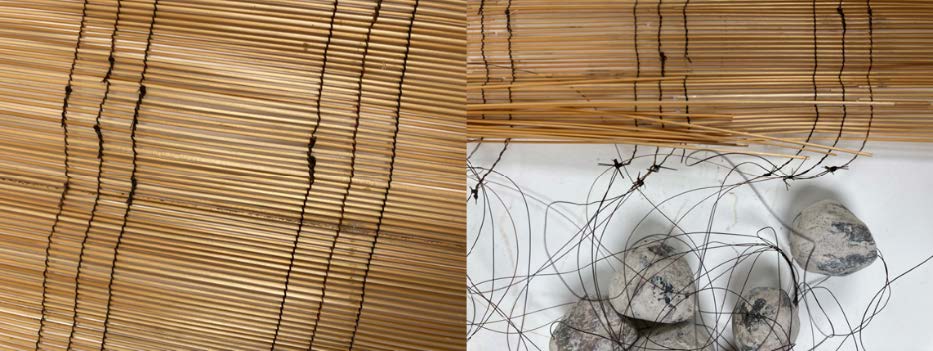
With scientific tools, the study aimed to understand more about the fibers commonly used in traditional handmade paper-mold covers in the 1930s Indian subcontinent by using scientific tools. With the availability of high-resolution microscopy technologies and historical documentation at Georgia Tech and the Museum, researchers aimed to either prove or disprove whether the origin of preserved fibers on the loom was from an animal and determine with historical context where the loom was acquired.
What we did and what we discovered
Are the Fibers Really Horsehair?
In forensic analysis, typically the first step to identify unknown fiber or hair samples is to conduct microscopy. Microscopy, or the science of using microscopes to view samples & objects that cannot be seen with the naked eye, is the gold standard for analyzing and identifying unknown fibers by comparison to a library of known reference materials. This is possible because hair from different sources or animals have different “morphologies”, or physical features, that help identify their origin. Thanks to the Materials Innovation and Learning Laboratory (MILL), a hub of scientific equipment for hands-on scientific training of undergraduates at Georgia Tech, the researchers were able to use two different microscope techniques: Light microscopy and Scanning Electron Microscopy (SEM). Thanks to Little Creek Farm Conservancy in Decatur and Kristine Parson, the researchers were able to obtain reference materials for tail and mane horsehair from two horses: Angus and Lightening.
Click the link below to continue reading the story.
Virginia Howell | |Director of the Robert C. Williams Museum of Papermaking
Stingelin Elected to European Academy of Sciences
Sep 13, 2023 — Atlanta, GA
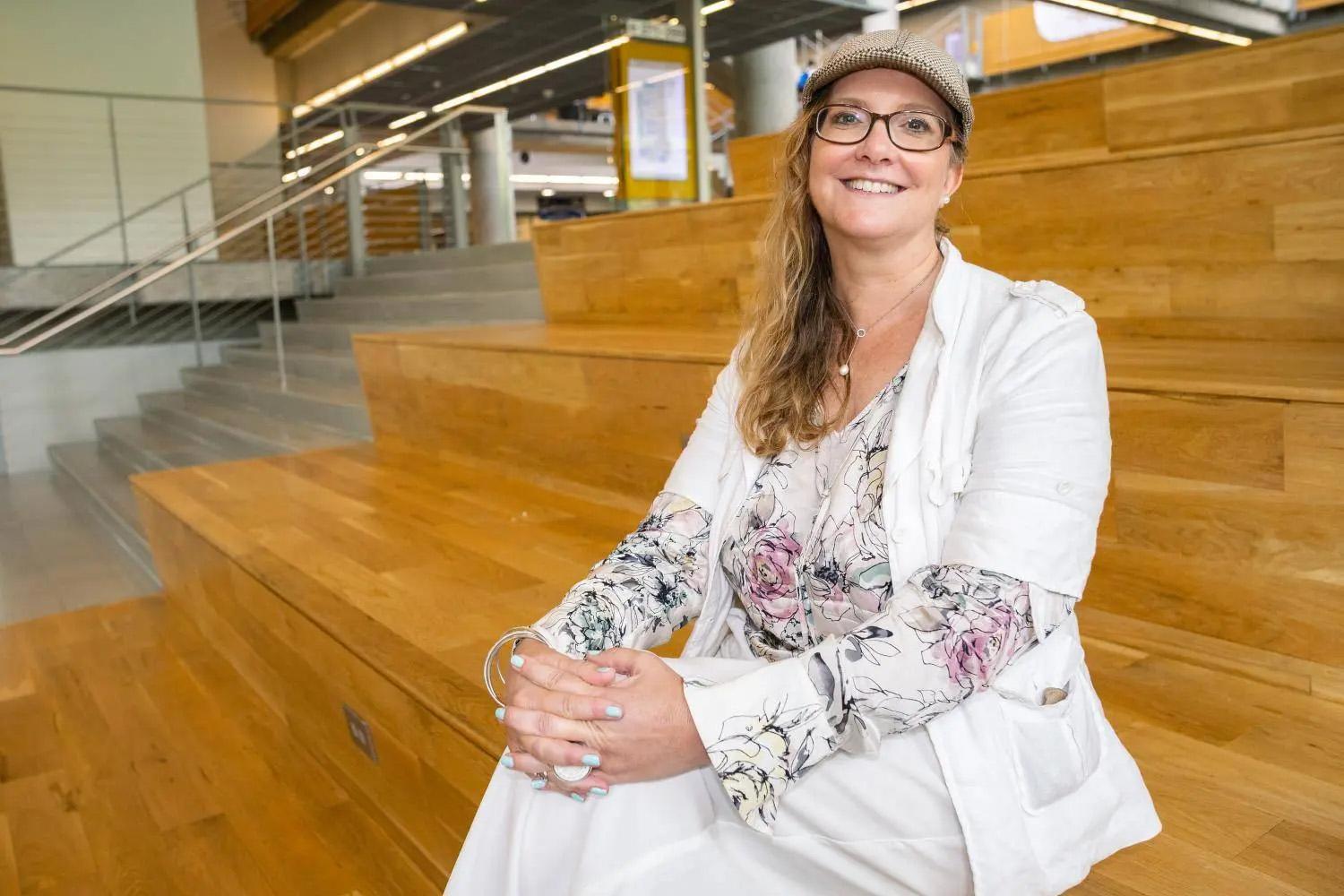
Picture of Natalie Stingelin
MSE chair Natalie Stingelin, has received a prestigious accolade by being elected to the European Academy of Sciences (EURASC). This esteemed recognition is reserved for outstanding European scholars and engineers who have made significant contributions to advanced technologies and scientific research while actively promoting the growth of science and technology within Europe.
Stingelin's noteworthy achievements span various fields, including polymer physics, functional macromolecular materials, and organic electronics and photonics. Her dedication extends beyond her research, as she is also recognized for her unwavering commitment to advancing the engineering field and serving as a role model for women pursuing careers in STEM (Science, Technology, Engineering, and Mathematics).
In response to her election, Stingelin expressed her deep appreciation for the recognition from her European peers. She acknowledged the evolution of her career, from her upbringing in the Swiss Mountains to her current leadership role in a globally recognized science and engineering group. She eagerly anticipates the 2023 EURASC Symposium & Ceremony, which will be hosted in Madrid by invitation of the Real Academia de Ciencias Exactas, Físicas y Naturales de España.
MSE Professor Blair Brettmann and CHBE student Alexa Dobbs Spends Summer at LLNL Exploring Materials Processing and Manufacturing
Sep 05, 2023 — Livermore, CA

MSE professor Blair Brettmann (left) and CHBE doctoral student Alexa Dobbs (right) spent the summer at LLNL, collaborating with LLNL experts to explore techniques that can help them with their materials science research. Photo: Garry McLeod/LLNL.
MSE Professor Blair Brettmann and CHBE doctoral student Alexa Dobbs decided to spend a summer at Lawrence Livermore National Laboratory (LLNL) to collaborate with the Lab’s materials science experts and learn more about LLNL’s experimental resources. During Brettmann’s faculty mini-sabbatical, she collaborated with researchers from LLNL’s Energetic Materials Center to refine material manufacturing techniques.
According to LLNL materials scientist Kyle Sullivan, who sponsored Brettmann’s mini-sabbatical, she helped his team take a fresh look at their methodology, enabling them to identify ways to streamline a highly complex process.
“Many of our material development activities start with multi-faceted problems,” Sullivan said. “We were eager to draw from Blair’s experience in pharmaceutical manufacturing to help us identify an efficient methodology to apply to our research.”
Brettmann’s research focuses on material processing, including how a material’s properties influence the optimal processing approach, as well as how novel processing techniques can be used to develop materials with the features needed for specific applications. Her goal is to better understand options for real-time monitoring of material processing, including effective data collection tools, as well as knowing which experimental data would be beneficial to analyze. As she heads back to Georgia Tech to start another academic year, Brettmann is hoping that the insight she gained during her mini-sabbatical will help her research team as they test new analytical techniques for their material formulation experiments.
New Water Treatment Approach Helps to Avoid Harmful Chemicals
Sep 11, 2023 — Atlanta, GA

The water coming out of your faucet is safe to drink, but that doesn’t mean it’s completely clean. Chlorine has long been the standard for water treatment, but it often contains trace levels of disinfection byproducts and unknown contaminants. Georgia Institute of Technology researchers developed the minus approach to handle these harmful byproducts.
Instead of relying on traditional chemical addition (known as the plus approach), the minus approach avoids disinfectants, chemical coagulants, and advanced oxidation processes typical to water treatment processes. It uses a unique mix of filtration methods to remove byproducts and pathogens, enabling water treatment centers to use ultraviolet light and much smaller doses of chemical disinfectants to minimize future bacterial growth down the distribution system.
“The minus approach is a groundbreaking philosophical concept in water treatment,” said Yongsheng Chen, the Bonnie W. and Charles W. Moorman IV Professor in the School of Civil and Environmental Engineering. “Its primary objective is to achieve these outcomes while minimizing the reliance on chemical treatments, which can give rise to various issues in the main water treatment stream.”
Chen and his student Elliot Reid, the primary author, presented the minus approach in the paper, “The Minus Approach Can Redefine the Standard of Practice of Drinking Water Treatment,” in The American Chemical Society.
The minus approach physically separates emerging contaminants and disinfection byproducts from the main water treatment process using these already proven processes:
- Bank filtration withdraws water from naturally occurring or constructed banks like rivers or lakes. As the water travels through the layers of soil and gravel, it naturally filters out impurities, suspended particles, and certain microorganisms.
- Biofiltration uses biological processes to treat water by passing it through filter beds made of sand, gravel, or activated carbon that can support the growth of beneficial microorganisms, which in turn can remove contaminants.
- Adsorption occurs when an adsorbent material like activated carbon is used to trap contaminants.
- Membrane filtration uses a semi-permeable membrane to separate particles and impurities from the main treatment process.
The minus approach is intended to engage the water community in designing safer, more sustainable, and more intelligent systems. Because its technologies are already available and proven, the minus approach can be implemented immediately.
It can also integrate with artificial intelligence (AI) to improve filtration’s effectiveness. AI can aid process optimization, predictive maintenance, faulty detection and diagnosis, energy optimization, and decision-support systems. AI models have also been able to reliably predict the origin of different types of pollution in source water, and models have also successfully detected pipeline damage and microbial contamination, allowing for quick and efficient maintenance.
“This innovative philosophy seeks to revolutionize traditional water treatment practices by providing a more sustainable and environmentally friendly solution,” Chen said. “By reducing the reliance on chemical treatments, the minus approach mitigates the potential risks associated with the use of such chemicals, promoting a safer water supply for both human consumption and environmental protection.”
CITATION: Elliot Reid, Thomas Igou, Yangying Zhao, John Crittenden, Ching-Hua Huang, Paul Westerhoff, Bruce Rittmann, Jörg E. Drewes, and Yongsheng Chen
Environmental Science & Technology 2023 57 (18), 7150-7161
DOI: 10.1021/acs.est.2c09389
Tess Malone, Senior Research Writer/Editor
tess.malone@gatech.edu
2023 RBI Spring Workshop Experience From a Student's Perspective - Part 2
Aug 30, 2023 — Atlanta, GA
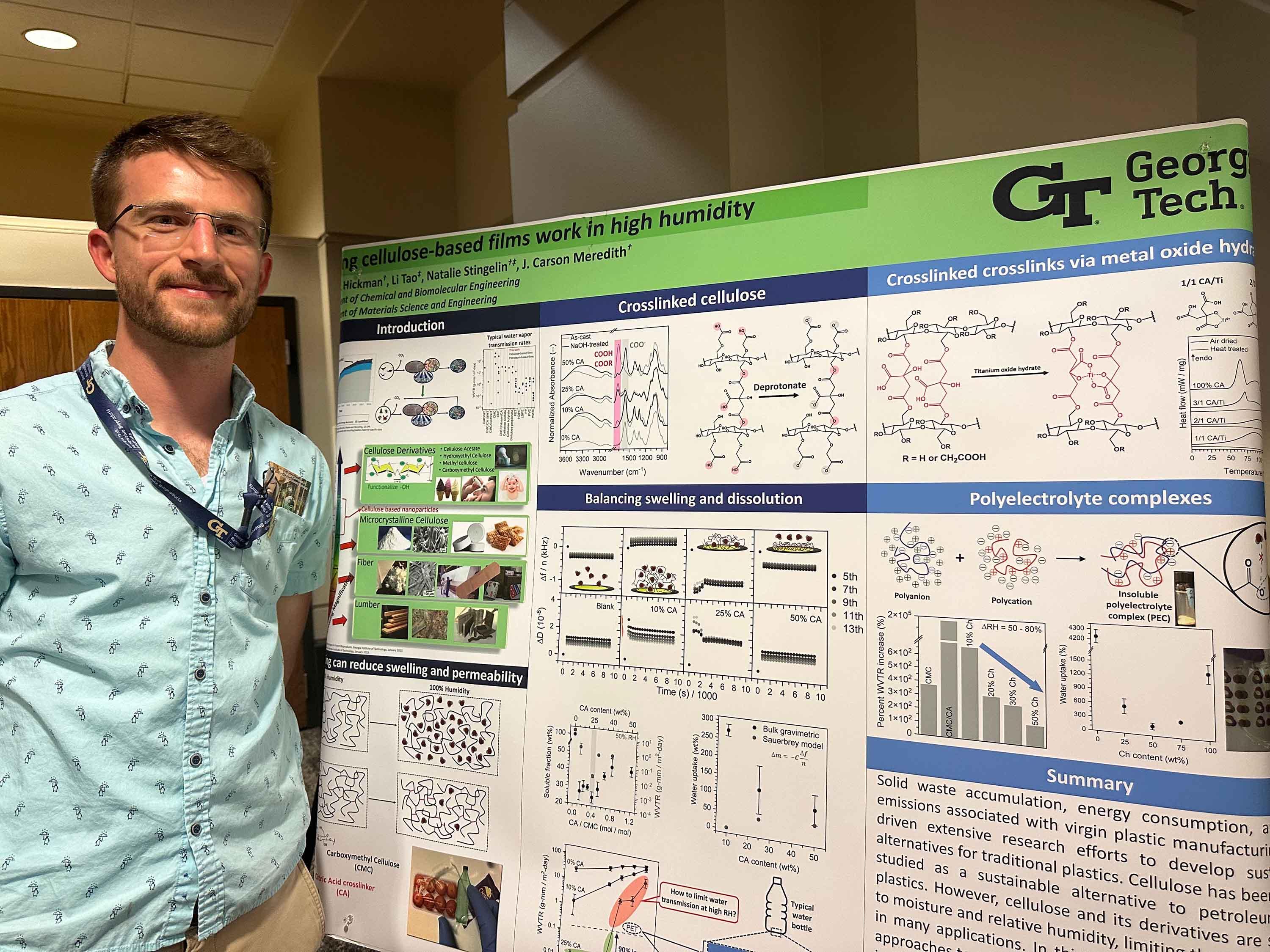
Tanner Hickman at the 2023 RBI Spring Workshop
This is part two of the student experiences series. Tanner Hickman, fourth-year Ph.D. candidate in chemical and biomolecular engineering shares his experience from the 2023 RBI Spring Workshop on "Innovations in Packaging and Circular Economy."
Tell us about yourself.
I am Tanner Hickman and I completed my bachelor’s degree in chemical and biomolecular engineering at the University of South Alabama. Here at Georgia Tech, I am a fourth-year Ph.D. candidate in chemical and biomolecular engineering, advised by Carson Meredith and Natalie Stingelin. My research focuses on exploring different ways to control the properties of natural polymers to make them useful for new applications.
How was your experience at the RBI workshop?
The RBI workshop provided incredibly valuable insights. I gained a comprehensive understanding of the persistent challenges within sustainable packaging, as well as the ongoing research endeavors aimed at tackling them. A key lesson I extracted from the workshop underscores the imperative of a circular economy within the packaging sector. However, it's crucial to note that our focus shouldn't solely revolve around product research; we must also direct attention toward addressing social concerns and broader issues.
What was your main takeaway from the poster session?
One of the best parts of RBI workshops is the opportunities to talk with people from different technical backgrounds, and poster sessions are one of the best ways to get the exchange of ideas flowing. I talked with several people from industry, who all had valuable advice on what it takes to bring benchtop research to application on a larger scale. At the same time, discussions with other researchers in academia are vital for brainstorming new projects, forming collaborations, etc.
What more would you like to see in future events at the Renewable Bioproducts Institute?
I would like to see a workshop that incorporates more interactive elements (in addition to the poster session) to engage participants. For instance, roundtable discussions or panel sessions where experts and attendees can openly exchange ideas and insights could enhance the learning experience.

Priya Devarajan || RBI Communications Program Manager
Chris Luettgen appointed as APPTI Executive Director
Apr 03, 2023 — Atlanta, GA
Christopher Luettgen, professor of the practice at the School of Chemical and Biomolecular Engineering and associate director of the Renewable Bioproducts Institute (RBI) has been named as the new Executive Director of the Alliance for Pulp & Paper Technology Innovation (APPTI), effective April 1, 2023.

Portrait of Chris Luettgen
Luettgen has over 25 years of industry experience, with Scott Paper and Kimberly-Clark Corp., where he most recently served as senior research and engineering manager for the Kimberly-Clark Professional business sector. He has held positions in product development and innovation as well as in capital project management and manufacturing facility leadership.
For several years, Luettgen has served on the RBI Industry Board of Advisors, and he is the current Chairman of the Board of the Technical Association of the Pulp & Paper Industry. He earned his bachelor's degree in Paper Engineering at Western Michigan University (’85), his master’s degree at the Institute of Paper Chemistry, Appleton, WI (’87), and his Ph.D. at the Institute of Paper Science and Technology - now the Renewable Bioproducts Institute at Georgia Tech (’91).
He rejoined Georgia Tech in November 2014 as a Professor of the Practice in the School of Chemical and Biomolecular Engineering, and Associate Director of Pulp and Paper at RBI. He also serves as Director of Industry Strategic Partnerships in the Georgia Tech Professional Education Division.
His areas of interest include: Recycled fiber, renewable cellulosic feedstocks, tissue manufacturing and converting and manufacturing leadership / operations excellence.
Priya Devarajan || RBI Communications Manager
